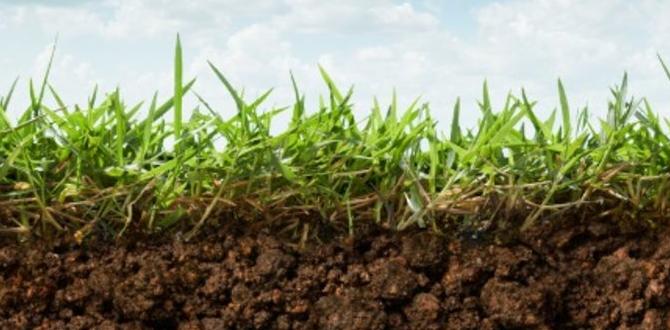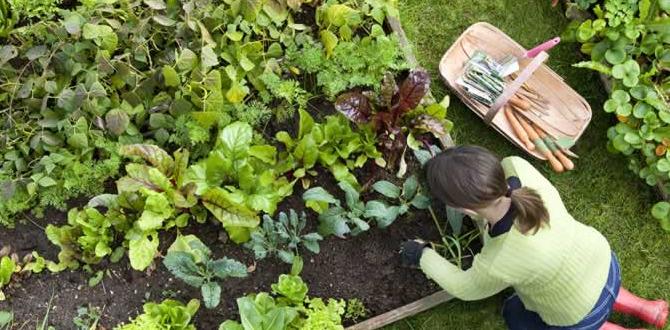Create your own miniature green world with this essential guide to terrarium plants and setup. Learn how to choose the right plants, select the perfect container, and assemble your beautiful, self-sustaining ecosystem with easy, step-by-step instructions.
Dreaming of bringing a touch of lush greenery into your home but worried about keeping plants alive? Many people find plant care a bit daunting, especially when it comes to finding the right plants for specific conditions. If you’ve ever admired those beautiful, self-contained plant worlds – those enchanting terrariums – and thought, “I could never do that,” think again! Building a thriving terrarium is surprisingly simple, even for absolute beginners. We’ll walk you through everything you need to know to create your very own vibrant, living masterpiece.
What Exactly is a Terrarium?
A terrarium is essentially a miniature garden housed inside a glass container. This container can be open or closed. Closed terrariums create a humid, self-sustaining environment where water is recycled, mimicking a mini rainforest. Open terrariums are better suited for plants that prefer drier conditions, like succulents and cacti, as they allow more air circulation.
Why Build a Terrarium?
Terrariums are more than just pretty decorations. They offer a unique way to connect with nature, even in the smallest living spaces. They’re incredibly low-maintenance once established, especially closed terrariums, which require watering only very occasionally. They can also be a fantastic educational tool for children, teaching them about ecosystems and plant life cycles in a hands-on way. Plus, they’re a fantastic outlet for creativity and a wonderful DIY project!
Choosing Your Terrarium Container
The container is the foundation of your terrarium. Almost any clear glass container can be used, from old pickle jars to specialized terrarium vessels. The key is that it’s clear, allowing light to reach your plants.
Types of Terrarium Containers:
- Closed Containers: These have a lid and are perfect for creating a humid environment. Think jars with cork stoppers, apothecary jars, or even old fish bowls with custom-fitted lids.
- Open Containers: These lack a lid and allow for better air circulation. Bowls, vases, or even shallow dishes work well here.
- Unique Shapes: Get creative! Geometric glass terrariums, repurposed light bulbs (with careful preparation), or even old cloches can make stunning homes for your plants.
When selecting a container, consider its size and the space you have available. Also, think about how you’ll access it for planting and occasional maintenance. Wider openings are generally easier for beginners!
Essential Terrarium Setup Supplies
Beyond the container, you’ll need a few key components to create a healthy environment for your miniature garden guests.
The Drainage Layer
This is crucial, especially for closed terrariums, to prevent waterlogged soil and root rot. A layer of gravel, pebbles, or LECA (lightweight expanded clay aggregate) at the bottom allows excess water to drain away from the soil.
Activated Charcoal
A thin layer of activated charcoal (available at pet stores or garden centers) acts as a filter. It helps keep the terrarium fresh by absorbing odors and impurities from the water and soil.
Barrier Layer (Optional but Recommended)
A thin layer of sphagnum moss or a piece of landscape fabric placed between the drainage layer and the soil prevents the soil from sifting down into the gravel, keeping your drainage system clear.
Potting Mix
The right soil is vital. For closed terrariums, a well-draining potting mix that retains some moisture is ideal. A mix designed for houseplants or a blend of potting soil, peat moss, and perlite works well. For open terrariums housing succulents or cacti, use a specialized succulent or cactus mix for excellent drainage.
Tools for Planting
Long tweezers, a small trowel or spoon, and a paintbrush or small brush are incredibly useful for placing plants, arranging soil, and cleaning the inside of the glass.
Choosing the Right Terrarium Plants
Selecting plants that thrive in terrarium conditions is perhaps the most exciting part! The type of plants you choose will depend on whether you’re making a closed or open terrarium.
Plants for Closed Terrariums (High Humidity Lovers)
These plants love the moist, humid environment created within a sealed container. They are generally adapted to low-light conditions found in the understory of a rainforest.
- Ferns: Small varieties like Button Fern (Pellaea rotundifolia) or Maidenhair Fern (Adiantum spp.) thrive in humidity.
- Mosses: Sheet moss, mood moss, and cushion moss are perfect for ground cover and add that lush, forest floor look.
- Peperomia: Many small Peperomia varieties, such as Peperomia caperata or Peperomia prostrata (String of Turtles), do well.
- Fittonia (Nerve Plant): Known for its striking colored veins, Fittonia loves humidity and can tolerate lower light.
- Pilea: Small varieties like Pilea cadierei (Aluminum Plant) or Pilea involucrata (Friendship Plant) are excellent choices.
- Selaginella (Spikemoss): These are not true mosses but are closely related and love high humidity.
- Air Plants (Tillandsia): While some prefer airflow, certain air plant varieties can adapt to a humid terrarium, but ensure they have some air exchange if possible.
When selecting plants for a closed terrarium, look for small, slow-growing varieties that tolerate shade and high humidity. Avoid succulents and cacti, as they will rot.
Plants for Open Terrariums (Dry and Airy)
These plants prefer drier conditions and good air circulation. They are typically succulents, cacti, or air plants that can tolerate more arid environments.
- Succulents: Echeverias, Sedums, Haworthias, and Sempervivums (Hens and Chicks) are all excellent options.
- Cacti: Small, slow-growing varieties of cacti can work, but ensure they have very good drainage and plenty of light.
- Air Plants (Tillandsia): These are ideal for open terrariums. They don’t need soil and can be placed among rocks or decorative elements. Just remember to mist them regularly.
For open terrariums with succulents, it’s crucial to use a well-draining cactus/succulent mix and ensure ample light. Water sparingly!
Step-by-Step: Setting Up Your Terrarium
Ready to get your hands dirty? Follow these simple steps to build your terrarium masterpiece.
Step 1: Clean Your Container
Thoroughly wash and dry your glass container. Any residue can affect plant health or create unwanted algae growth.
Step 2: Add the Drainage Layer
Pour a 1-2 inch layer of gravel or LECA into the bottom of your container. The depth will depend on the size of your container. This layer is essential for preventing waterlogged soil.
Step 3: Add Activated Charcoal
Sprinkle a thin layer (about ½ inch) of activated charcoal evenly over the gravel. This keeps the terrarium environment fresh.
Step 4: Add the Barrier Layer (Optional)
Place a thin layer of sphagnum moss or landscape fabric over the charcoal. This prevents the soil from mixing with the drainage layers.
Step 5: Add Your Potting Mix
Add your chosen potting mix. The amount of soil needed will depend on the root systems of your plants. Aim for enough depth to comfortably plant them. For most small terrariums, 2-4 inches is usually sufficient.
Step 6: Plan Your Layout
Before planting, place your plants (still in their nursery pots) into the terrarium to visualize your arrangement. Consider the height, color, and texture of each plant. Taller plants usually go towards the back or center, while smaller ones fill in the front.
Step 7: Plant Your Terrarium
Gently remove each plant from its nursery pot. Loosen the root ball slightly if it’s tightly bound. Dig small holes in the soil and carefully place each plant. Use your long tweezers or spoon to tuck soil around the roots, ensuring the plants are secure.
Step 8: Add Decorative Elements (Optional)
Once your plants are in place, you can add mosses, small stones, driftwood, or figurines to enhance the aesthetic and create a miniature landscape.
Step 9: Clean and Water
Use a damp cloth or paper towel to wipe down the inside walls of the terrarium, removing any soil smudges. For closed terrariums, lightly mist the plants and soil. For open terrariums with succulents, water sparingly around the base of each plant.
Step 10: Seal (for Closed Terrariums)
Place the lid on your closed terrarium. You’ve now created a self-sustaining ecosystem!
Terrarium Care and Maintenance
Even the most self-sufficient terrariums need a little attention now and then.
Light:
Most terrarium plants prefer bright, indirect light. Direct sunlight can scorch leaves and overheat the glass, especially in closed terrariums. A spot near an east or north-facing window is often ideal.
Watering:
- Closed Terrariums: These are designed to recycle water. You’ll know it’s time to water if you don’t see any condensation on the glass for a few days. Water very sparingly, just a few drops or a light mist. If you see too much condensation, remove the lid for a few hours to allow it to air out.
- Open Terrariums: Water succulents and cacti only when the soil is completely dry. This might be every 2-4 weeks, depending on your environment. Air plants need regular misting, usually 1-2 times a week.
A good rule of thumb for closed terrariums: “When in doubt, don’t water.” Overwatering is the most common way to kill terrarium plants.
Pruning and Cleaning:
Occasionally, you may need to trim plants that are outgrowing the space or remove any yellowing or dead leaves to prevent mold. Wipe down the inside of the glass with a clean cloth if it becomes cloudy.
Pest Control:
Pests are rare in well-maintained terrariums. If you notice any, isolate the terrarium and treat with a gentle, natural pest control solution. For small infestations, physical removal with tweezers might be enough.
Troubleshooting Common Terrarium Issues
Even with the best intentions, you might encounter a few bumps. Here’s how to fix them.
Problem: Excessive Condensation (Closed Terrariums)
Cause: Too much moisture, or the terrarium is too warm.
Solution: Remove the lid for several hours or even a day to allow excess moisture to evaporate. Ensure the terrarium isn’t in direct sunlight.
Problem: Mold or Fungal Growth
Cause: Overwatering, poor air circulation, or decaying organic matter.
Solution: Remove any affected plant parts or mold. If widespread, you may need to replace the soil and some plants. Ensure adequate airflow when possible and reduce watering.
Problem: Plants Wilting or Yellowing
Cause: Can be due to underwatering, overwatering, or insufficient light. Yellowing leaves often indicate overwatering, while wilting can be either.
Solution: Assess your watering schedule and the amount of light. For closed terrariums, lack of condensation might mean it’s time for a light watering. For open terrariums, check if the soil is dry and water accordingly.
Problem: Pests (e.g., Fungus Gnats, Spider Mites)
Cause: Pests can be introduced with new plants or soil.
Solution: Isolate the terrarium. For fungus gnats, allow the top layer of soil to dry out. You can also use sticky traps. For mites, try gently wiping plants with a damp cloth or a diluted neem oil solution (use sparingly).
Fantastic Terrarium Plant Combinations
Here are some ideas to inspire your terrarium design:
The Woodland Wonder (Closed Terrarium)
- Base: Sheet moss and cushion moss
- Plants: Small varieties of ferns (Maidenhair, Button Fern), Peperomia ‘Prostrata’ (String of Turtles), Pilea involucrata (Friendship Plant).
- Accents: Small pieces of driftwood, tiny sculpted mushrooms.
The Desert Oasis (Open Terrarium)
- Base: Coarse horticultural sand or gravel mix
- Plants: Various small Echeverias, Haworthias, and a tiny Opuntia cactus.
- Accents: Smooth river stones, a small piece of sun-bleached wood.
The Tropical Nook (Closed Terrarium)
- Base: Dark, rich potting mix
- Plants: Fittonia (Nerve Plant) in vibrant colors, Selaginella, small creeping fig (Ficus pumila).
- Accents: Larger pebbles, a miniature stone figurine.
Creating a Thriving Ecosystem: The Science Behind It
Understanding the science makes building and appreciating your terrarium even more rewarding. A closed terrarium is a self-contained ecosystem that mimics the Earth’s water cycle. Here’s how it works:
- Photosynthesis: Plants absorb light to produce energy and release oxygen.
- Transpiration: Plants release water vapor from their leaves.
- Condensation: This water vapor rises, cools when it hits the cooler glass walls, and condenses into water droplets.
- Precipitation: These droplets drip down the sides of the glass and return to the soil, watering the plants.
This continuous cycle means that, under the right conditions, a closed terrarium rarely needs additional watering. It’s a beautiful demonstration of nature’s efficiency.
DIY Terrarium Inspiration and Resources
Looking for more ideas? Explore reputable gardening sites for endless inspiration. The Royal Horticultural Society (RHS) offers excellent advice on plant care and gardening techniques that can be applied to terrarium design.
For more specific information on plant care for indoor gardening, the Clemson University Home & Garden Information Center provides reliable, research-based resources on houseplant care, many of which are suitable for terrariums.
Many online communities and blogs dedicated to indoor gardening and DIY projects also offer fantastic visual inspiration and tips for unique terrarium builds. Don’t be afraid to experiment with different containers and plant combinations!
Frequently Asked Questions About Terrariums
Q1: How often should I water a closed terrarium?
A: Very rarely! A healthy closed terrarium recycles its own water. You only need to water it when you notice there’s no condensation on the glass for several days. A light misting is usually sufficient.
Q2: Can I use regular potting soil in my terrarium?
A: For closed, humid terrariums, a good quality potting mix that holds some moisture but still drains well is best. For open terrariums with succulents, a specialized cactus/succulent mix with excellent drainage is essential.
Q3: What if my terrarium plants grow too big?
A: You’ll need to prune them! Use clean, sharp scissors or small pruning shears to trim back any plants that are becoming too large for the container or are overcrowding others. Remove dead or yellowing leaves promptly.
Q4: Can I put succulents and ferns in the same terrarium?
A: Generally, no. Succulents and cacti prefer dry, airy conditions, while ferns and mosses thrive in high humidity. They have very different needs, so it’s best to create separate open terrariums for succulents and closed terrariums for humidity-loving plants.
Q5: My terrarium has a cloudy or foggy appearance inside. What should I do?
A: This usually means there’s too much moisture. Remove the lid of your closed terrarium for a few hours to allow excess moisture to evaporate. Make sure it’s not placed in direct sunlight, which can exacerbate the problem.
Q6: How much light do terrarium plants need?
A: Most terrarium plants, especially those for closed terrariums, prefer bright, indirect light. Avoid direct sunlight, as it can overheat the glass and scorch the plants. A spot near an east or north-facing window is often ideal.






